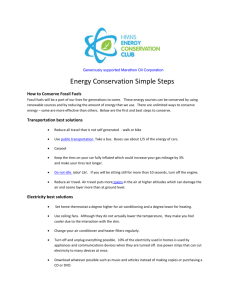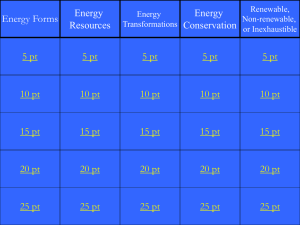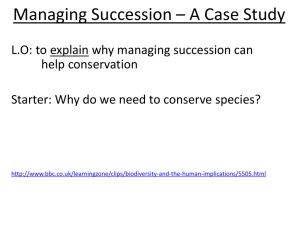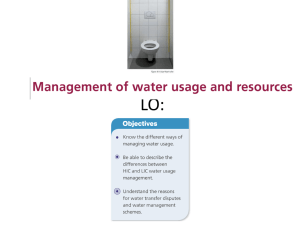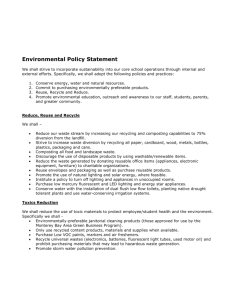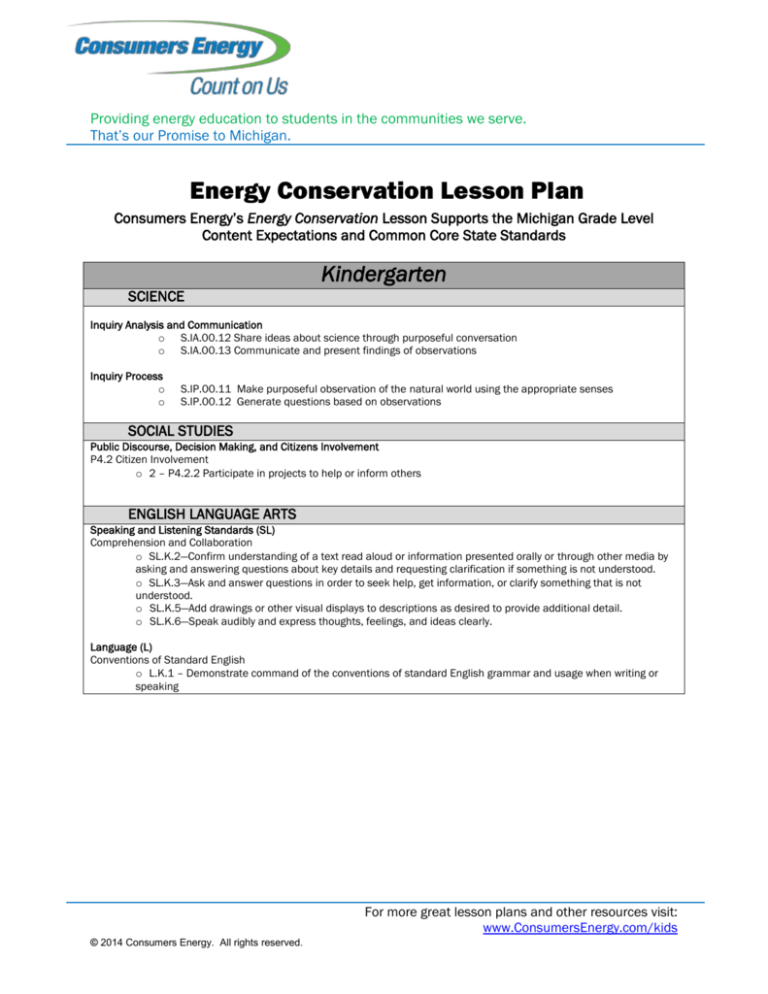
Providing energy education to students in the communities we serve.
That’s our Promise to Michigan.
Energy Conservation Lesson Plan
Consumers Energy’s Energy Conservation Lesson Supports the Michigan Grade Level
Content Expectations and Common Core State Standards
Kindergarten
SCIENCE
Inquiry Analysis and Communication
o S.IA.00.12 Share ideas about science through purposeful conversation
o S.IA.00.13 Communicate and present findings of observations
Inquiry Process
o
o
S.IP.00.11 Make purposeful observation of the natural world using the appropriate senses
S.IP.00.12 Generate questions based on observations
SOCIAL STUDIES
Public Discourse, Decision Making, and Citizens Involvement
P4.2 Citizen Involvement
o 2 – P4.2.2 Participate in projects to help or inform others
ENGLISH LANGUAGE ARTS
Speaking and Listening Standards (SL)
Comprehension and Collaboration
o SL.K.2—Confirm understanding of a text read aloud or information presented orally or through other media by
asking and answering questions about key details and requesting clarification if something is not understood.
o SL.K.3—Ask and answer questions in order to seek help, get information, or clarify something that is not
understood.
o SL.K.5—Add drawings or other visual displays to descriptions as desired to provide additional detail.
o SL.K.6—Speak audibly and express thoughts, feelings, and ideas clearly.
Language (L)
Conventions of Standard English
o L.K.1 – Demonstrate command of the conventions of standard English grammar and usage when writing or
speaking
For more great lesson plans and other resources visit:
www.ConsumersEnergy.com/kids
© 2014 Consumers Energy. All rights reserved.
Providing energy education to students in the communities we serve.
That’s our Promise to Michigan.
First Grade
SCIENCE
Inquiry Analysis and Communication
o S.IA.01.12 Share ideas about science through purposeful conversation
o S.IA.01.13 Communicate and present findings of observations
Inquiry Process
o
o
S.IP.01.11 Make purposeful observation of the natural world using the appropriate senses
S.IP.01.12 Generate questions based on observations
SOCIAL STUDIES
Public Discourse, Decision Making, and Citizens Involvement
P4.2 Citizen Involvement
o 2 – P4.2.2 Participate in projects to help or inform others
ENGLISH LANGUAGE ARTS
Reading Standards for Informational Text (RI)
Integration of Knowledge and Ideas
o RI.1.7—Use the illustrations and details in a text to describe its key ideas.
Writing Standards (W)
Research to Build and Present Knowledge
o W.1.8—With guidance and support from adults, recall information from experiences or gather information from
provided sources to answer a question.
Speaking and Listening Standards (SL)
Comprehension and Collaboration
o SL.1.2—Ask and answer questions about key details in a text read aloud or information presented orally or
through other media.
o SL.1.3—Ask and answer questions about what a speaker says in order to gather additional information or
clarify something that is not understood.
o SL.1.5—Add drawings or other visual displays to descriptions when appropriate to clarify ideas, thoughts, and
feelings.
Language (L)
Conventions of Standard English
o L.1.1 – Demonstrate command of the conventions of standard English grammar and usage when writing or
speaking
For more great lesson plans and other resources visit:
www.ConsumersEnergy.com/kids
© 2014 Consumers Energy. All rights reserved.
Providing energy education to students in the communities we serve.
That’s our Promise to Michigan.
Second Grade
SCIENCE
Inquiry Analysis and Communication
o S.IA.02.12 Share ideas about science through purposeful conversation
o S.IA.02.13 Communicate and present findings of observations
Inquiry Process
o
o
S.IP.02.11 Make purposeful observation of the natural world using the appropriate senses
S.IP.02.12 Generate questions based on observations
SOCIAL STUDIES
Public Discourse, Decision Making, and Citizens Involvement
P4.2 Citizen Involvement
o 2 – P4.2.2 Participate in projects to help or inform others
ENGLISH LANGUAGE ARTS
Speaking and Listening Standards (SL)
Comprehension and Collaboration
o SL.2.2—Recount or describe key ideas or details from a text read aloud or information presented orally or
through other media.
o SL.2.3—Ask and answer questions about what a speaker says in order to clarify comprehension, gather
additional information, or deepen understanding of a topic or issue.
Language (L)
Conventions of Standard English
o L.2.1 – Demonstrate command of the conventions of standard English grammar and usage when writing or
speaking
For more great lesson plans and other resources visit:
www.ConsumersEnergy.com/kids
© 2014 Consumers Energy. All rights reserved.
Providing energy education to students in the communities we serve.
That’s our Promise to Michigan.
Lesson Outcome
Students will identify what appliances use electricity to make them work in their home and
school. They will also discuss and learn how we can conserve electricity in our homes and
schools. They will create tools to help them remember to conserve energy at home and at
school.
Rationale / Purpose for Lesson
This lesson will provide students an opportunity to take a look at common items they see in
their daily lives and discuss whether or not they use electricity to make them work. Students
will learn that electricity is made in many different ways, but we don’t have an infinite supply,
so we need to find ways to conserve or save it. They will discuss and learn to turn things off
when they aren’t using them, not only to save money, but to help the environment.
Resources / Materials Required
Print off one worksheet below
Prepare materials needed to make craft
Technology needed to show recommended you tube video
11 x 17 paper or larger if desired
Crayons, colored pencils, markers, and pencils
Anticipatory Set
Start the lesson by discussing how you use electricity when you turn on a light switch or a TV.
Discuss how electricity wasn’t invented, it was discovered. Now, ask the students to tell you
about some things they use that are plugged into an outlet and what happens when they
turn them on. Brainstorm many examples of items that use electricity. Now discuss with
your students what it means to conserve energy? Then ask them, how can we conserve
energy with some of the appliances we listed?
For more great lesson plans and other resources visit:
www.ConsumersEnergy.com/kids
© 2014 Consumers Energy. All rights reserved.
Providing energy education to students in the communities we serve.
That’s our Promise to Michigan.
Procedures
1. The teacher begins by showing the segment titled “Energy Blues” from the
Schoolhouse Rock: Science Rock video.
https://www.youtube.com/watch?v=wX2wrXwe8ZM
2. Using the information from the video as a basis, the class discusses several
fuels/resources they notice in the video that make energy. (water, wind, wood, coal,
oil, nuclear, thermal, and solar)
3. Ask students then how can we conserve energy (remind them of how the little girl did
in the video while working at the desk) so our fuel will go further.
4. Place the students into groups of 3-4 and give each group an 11x17 or larger sheet if
desired.
5. Ask the students to discuss in their groups 5 ways they can conserve energy.
6. Then ask the students to create an energy message/slogan to help others to
remember to conserve energy at home or school.
7. Have them create a poster with their slogan/message on it along with pictures or
drawings to show others how they can conserve energy at home and school.
8. When they have finished the posters, have the students complete self-evaluations.
They should check the posters for accurate information as well as useful and realistic
methods for conserving energy resources. The posters can be hung later in the
hallway for everyone to see.
9. While others are finishing up their posters have students work on making a doorknob
decoration that reminds them to turn off the lights when they leave the room.
Closure
1. Have the students present their pictures to the class with descriptions and
explanations of the scenes.
2. Have the students name one thing that uses electricity in their house or classroom
(You may get duplicate answers) and tell you what they could do with one of them to
conserve energy. Ex. TV – turn it off when I’m not watching it.
3. Remind the students those things that run on electricity use energy and that if we
aren’t using them, we need to make sure to turn them off to conserve energy to help
the environment and help save on energy costs.
For more great lesson plans and other resources visit:
www.ConsumersEnergy.com/kids
© 2014 Consumers Energy. All rights reserved.
Providing energy education to students in the communities we serve.
That’s our Promise to Michigan.
Lights Out Reminder
Conserve energy with a doorknob decoration that reminds you to turn
off the lights when you leave the room.
What you’ll need
• Scissors
• Scrap cardboard (example: cereal box)
• Ruler
• Glue
• Markers
• Ribbon
How to make it
Draw and cut out a light bulb shape (about 3 1/2 inches wide and 6 inches tall) from the
cardboard.
For the base of the bulb (the green area in the picture), cut out a cardboard strip (about 1
1/2 inches wide and 3 inches long), wrap it around the neck of the bulb, and glue it in place.
Paint or color the light bulb and, once it dries, use a marker to draw threads on the bulb
base and print your message: Lights Out
For the hanger, tape a loop of ribbon or yarn to the back of the bulb.
For more great lesson plans and other resources visit:
www.ConsumersEnergy.com/kids
© 2014 Consumers Energy. All rights reserved.

